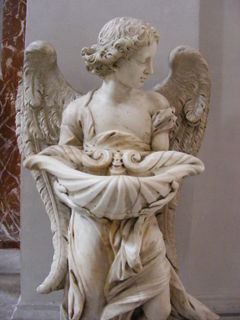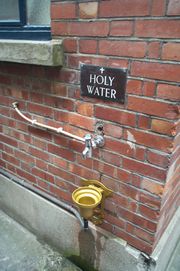Holy water

In Anglicanism, Catholicism, Eastern Orthodoxy, Lutheranism, Oriental Orthodoxy, and some other churches, holy water is water which has been sanctified by a priest or bishop for the purpose of baptism, the blessing of persons, places, and objects; or as a means of repelling evil.[1][2]
The first use of holy water, i.e. for baptism and spiritual cleansing, is common among several religions, from Christianity to Sikhism and Hinduism.
The second use of holy water, i.e. as a sacramental for protection against evil, is almost exclusive to Roman Catholics.[3]
Contents |
Holy water in Christianity
History
The use of holy water in the earliest days of Christianity is attested to only in somewhat later documents. The Apostolic constitutions which go back to about the year 400, attribute to the precept of using holy water to Apostle Matthew. Hence the first historical testimony goes back to the fifth century. However, it is plausible that, in the earliest Christian times, water was used for expiatory and purificatory purposes, to a way analogous to its employment under the Jewish Law. Yet, in many cases, the water used for the Sacrament of Baptism was flowing water, sea or river water, and it could not receive the same blessing as that contained in the baptisteries.[4]
Use and storage

Holy water is used as a sacramental in the baptismal ceremony.[5]
Holy water is kept in the font, the church furnishing used for baptisms, which is typically located at the entrance to the church (or sometimes in a separate room or building called a baptistery); its location at the entrance serves as a reminder of the centrality of baptism as the primary rite of initiation into the Christian faith. Smaller vessels, called stoups, are usually placed at the entrances of the church. As a reminder of baptism, Catholics dip their fingers in the holy water and make the sign of the cross when entering the church. The liturgy may begin on Sundays with the Rite of Blessing and Sprinkling Holy Water, in which holy water is sprinkled upon the congregation; this is called aspersion, from the Latin, asperges ("to sprinkle"). This ceremony dates back to the ninth century. An aspergill or aspergillum is a brush or branch used to sprinkle the water. An aspersorium is the vessel which holds the holy water and into which the aspergillum is dipped, though elaborate Ottonian examples are known as situlae. Blessed salt may be added to the water "where it is customary."
In Christianity, asperges is the name given to the rite of sprinkling a congregation with holy water. The name comes from the first word in the 9th verse of Psalm 51 in the Latin translation, the Vulgate, which is sung during the Traditional form of the rite, except during Eastertide.[6]
Proper disposal
In Catholicism, holy water, as well as water used during the washing of the priest's hands at mass, is not allowed to be disposed of in regular plumbing. Roman Catholic churches will usually have a special basin (a Sacrarium) that leads directly into the ground for the purpose of proper disposal. A hinged lid is kept over the holy water basin to distinguish it from a regular sink basin, which is often just beside it. Items that contain holy water are separated, drained of the holy water, and then washed in a regular manner in the adjacent sink.[7]
Hygiene
Holy water fonts have been identified as a potential source of bacterial and viral infection. Bacteriologists found staphylococci, streptococci, coli bacilli, Loeffler's bacillus, and other bacteria in samples of holy water taken from a church in Sassari, Italy in the late 1800s.[8] More recently, in a study performed in 1995, thirteen samples were taken when a burn patient acquired a bacterial infection after exposure to holy water. The samples were shown to have a "wide range of bacterial species," some of which could cause infection in humans.[9] During the swine flu epidemic of 2009, Bishop John Steinbock of Fresno, California recommended that "[h]oly water should not be in the fonts" due to fear of spreading infections.[10] Also in response to the swine flu, an automatic, motion-detecting holy water dispenser was invented and installed in an Italian church.[11]
Christian traditions
Anglicans
Holy water is not a term used in Anglican Church rites although font water is sanctified in the Church of England Anglican Baptism Rite.[12] However, the use of water within High Church Anglicanism or Anglo-Catholicism can adhere closely to Roman Catholic practice except that Anglicans do not believe sanctified water wards off evil. In many High Church Anglican churches Baptismal water is used for the asperges.[13]. Stoups with sanctified water are sometimes found near the doors of High Church Anglican churches for the faithful to use in making the sign of the cross upon entering the church.
Catholics
Sanctification
Traditionally, most Roman Catholic churches have stoups, or Holy water fonts to provide holy water in open fonts into which people dip their hands, and often make the sign of the cross. In recent years, with the concerns over influenza, new holy water machines that work like an automatic soap dispenser have become popular.[14]
This use of holy water and making a sign of the cross when entering a church reflects a renewal of baptism, a cleansing of venial sin, as well as providing protection against evil.[15] It is sometimes accompanied by the following prayer:[16]
"By this Holy water and by your Precious Blood, wash away all my sins O Lord".
Some Catholics believe that water from specific shrines such as the Lourdes Spring are means by which God chooses to bring healing.This water, technically, is not holy water in the same sense as traditional holy water since it has not been consecrated by a priest or bishop.[17]
Protection against evil

The Catechism of the Catholic Church (number 301) specifically refers to the use of holy water for "protection from the powers of darkness".[18] Lay Catholics are not permitted to perform exorcisms but they can use holy water and other sacramentals such as the Saint Benedict Medal or the Crucifix for warding off evil.[19]
Catholic saints have written about the power of holy water as a force that repels evil. Saint Teresa of Avila, a Doctor of the Church who reported visions of Jesus and Mary, was a strong believer in the power of holy water and wrote that she used it with success to repel evil and temptations.[20] She wrote:[21]
I know by frequent experience that there is nothing which puts the devils to flight like Holy water.
In Holy Water and Its Significance for Catholics Henry Theiler states that in addition to being a strong force in repelling evil, holy water has the twofold benefit of providing grace for both body and soul.[22]
Eastern Christians
Among Eastern Orthodox and Eastern-Rite Catholic Christians, holy water is used frequently in rites of blessing and exorcism, and the water for baptism is always sanctified with a special blessing.

There are two rites for blessing holy water: the Great Blessing of Waters which is held on the Feast of Theophany, and the Lesser Blessing of Waters which is conducted according to need during the rest of the year. Both forms are based upon the Rite of Baptism. Certain feast days call for the blessing of Holy Water as part of their liturgical observance.
Although Eastern Orthodox do not normally bless themselves with holy water upon entering a church like Catholics do, a quantity of holy water is typically kept in a font placed in the narthex (entrance) of the church, where it is available for anyone who would like to take some of it home with them.
Often, when objects are blessed in the church (such as the palms on Palm Sunday, Icons or sacred vessels) the blessing is completed by a triple sprinkling with holy water using the words, "This (name of item) is blessed by the sprinkling of this holy water, in the name of the Father, and of the Son, and of the Holy Spirit."
Throughout the centuries, there have been many springs of water that have been believed by members of the Orthodox Church to be miraculous. Some still flow to this day, such as the one at Pochaev Lavra in Ukraine, and the Life-Giving Spring of the Theotokos in Constantinople (commemorated on Bright Friday).
Methodists and Lutherans
The use of holy water within Methodism and Lutheranism is for the baptism of infants and new members of the church. The water is believed to be blessed by God, as it is used in a sacrament. The water is applied to the forehead of the laity being baptised and the clergyperson performs the sign of the cross. Lutherans tend to have holy water fonts at the entrance of the church.
Unofficial uses
Holy water has also been believed to ward off or act as a weapon against mythical evil creatures, such as vampires. In eastern Europe, one harboring this belief might sprinkle holy water onto the corpse of a suspected vampire in order to destroy it or render it inert.[23][24] Thereafter, the concept proliferated into fiction about such creatures.
Non-Christian traditions

In Ancient Greek religion, a holy water called chernips was created when extinguishing in it a torch from a religious shrine. In Greek religion, purifying people and locations with water was part of the process of distinguishing the sacred from the profane.[25]
Sikhs use the term (Punjabi: ਅੰਮ੍ਰਿਤ) for the holy water used in the baptism ceremony known as Amrit Sanskar or Amrit Chhakhna.[26]
Bathing in holy water is a key element in Hinduism and the River Ganges is considered the holiest Hindu river.[27]
Although the term holy water is not used, the idea of "blessed water" is used among Buddhists. Water is put in to a new pot and kept near a Paritrana ceremony, a blessing for protection. Thai 'Lustral water' can be created in a ceremony in which the burning and extinction of a candle above the water represents the elements of earth, fire, and air.[28] This water is later given to the people to be kept in their home. Not only water but also oil and strings are blessed in this ceremony. Bumpa, a ritual object, is one of the Ashtamangala, used for storing sacred water sometimes, symbolizing wisdom and long life in Vajrayana Buddhism.[29][30]
The drinking of "healing water" (āb-i shifā) is a practice in various denominations of Shi’a Islam. [31] In the tradition of the Twelver Shi’a, many dissolve the dust of sacred locations such as Karbala (khāk-i shifa) and Najaf and drink the water (āb-i shifā) as a cure for illness, both spiritual and physical. [32] The Ismaili tradition involves the practice of drinking water blessed by the Imam of the time. This water is taken in the name of the Imam and has a deep spiritual significance. This is evident from the names used to designate the water, including light (nūr) and ambrosia (amṛt, amī, amīras, amījal’’). This practice is recorded from the 13th and 14th centuries and continues to the present day. The ceremony is known as ghat-pat in South Asia.[33]
See also
- Holy water font
- Anglican devotions
- Catholic devotions
- Holy water sprinkler (disambiguation)
Gallery
Stoups
 Basilica of Notre-Dame de Fourvière, Lyon, France |
_-_Facade_-_Stoup.jpg) Church of Santa Maria a Cintoia, Florence, Italy. |
 Church of Saints Saint Cajetan and Maximillian, Salzburg, Austria |
References
- ↑ Chambers's encyclopædia, page 394, Published by Lippincott & Co (1870)
- ↑ Nathaniel Altman, 2002 Sacred water: the spiritual source of life ISBN 1587680130 pp 130-133
- ↑ Henry Theiler, 2003 Holy Water and Its Significance for Catholics ISBN 0766175537 pp 13-15
- ↑ Catholic encyclopedia on Holy water
- ↑ Sacramentals at thr Vatican website ss. 1667, 1668
- ↑ Catholic encyclopedia
- ↑ Henry Theiler, 2003 Holy Water and Its Significance for Catholics ISBN 0766175537 p 48
- ↑ Dietetic and Hygienic Gazette, Volume 14, page 578. The Gazette Publishing Company, 1898.
- ↑ J.C. Rees and K.D. Allen, 1996 "Holy water--a risk factor for hospital-acquired infection". Journal of Hospital Infection 32(1), pages 51-55.
- ↑ California Catholic Daily. "Holy water should not be in fonts during this epidemic <Internet>". 4 May, 2009.
- ↑ NPR Morning Edition. "In Italy, An Automatic Holy-Water Dispenser <Internet>". 12 November, 2009.
- ↑ Church of England Rite of Holy Baptism, The Archbishops' Council of the Church of England, 2000-2006
- ↑ Anglican Service Book
- ↑ BBC News on Holy Water dispensers
- ↑ Philip Bold, 2008 Catholic Doctorine and Discipline Simply Explained ISBN 1409786102 page 283
- ↑ Jacquelyn Lindsey, 2001 Catholic Family Prayer Book OSV Press ISBN 0879739991 page 65
- ↑ Richard Clarke, 2008 Lourdes, Its Inhabitants, Its Pilgrims, And Its Miracles ISBN 1408685418 page 38
- ↑ Thoms O'Brian, An Advanced Catechism Of Catholic Faith And Practice, Kessinger Publishers, 2005, ISBN 1417984473, page 151
- ↑ Rosemarie Scott, 2006 'Clean of Heart' ISBN 0977223450 page 63
- ↑ Tessa Bielecki, Mirabai Starr, 2008 Teresa of Avila: The Book of My Life ISBN 1590305736 pp 238-241
- ↑ Teresa of Avila, 2008 Life of St. Teresa of Jesus ISBN 1606800418 page 246
- ↑ Henry Theiler, 2003 Holy Water and Its Significance for Catholics ISBN 0766175537 pp 24-31
- ↑ Bonnerjea, Biren. A Dictionary of Superstitions and Mythology, Folk Press Limited, 1927, p. 242. [1]
- ↑ Library of universal knowledge: A reprint of the last (1880) Edinburgh and London edition of Chambers' encyclopaedia, with copious additions by American editors, Volume 14. American Book Exchange (Original from Harvard University), 1881, p. 804. [2]
- ↑ Greek religion: archaic and classical, by Walter Burkert, John Raffan 1991 ISBN 0631156240 page 77
- ↑ Sikhism, 2004, by Geoff Teece ISBN 1583404694 page 7
- ↑ Hinduism, 2004, by Geoff Teece ISBN 158340466X page 22
- ↑ "Buddhism in Thailand: Lustral Water". http://www.thailandlife.com/lustralwater.htm.
- ↑ Smithsonian Institution. "Buddhist ritual sprinkler (kundika) <Internet>". http://www.asia.si.edu/collections/singleObject.cfm?ObjectId=4442. Retrieved 16 July 2007.
- ↑ The British Museum. "Stoneware kundika (water sprinkler) <Internet>". http://www.thebritishmuseum.ac.uk/explore/highlights/highlight_objects/asia/s/stoneware_kundika_water_sprin.aspx. Retrieved 16 July 2007.
- ↑ Virani, Shafique. The Ismailis in the Middle Ages: A History of Survival, A Search for Salvation (New York: Oxford University Press), 2007, p.107-108.
- ↑ Virani, Shafique. The Ismailis in the Middle Ages: A History of Survival, A Search for Salvation (New York: Oxford University Press), 2007, p.107-108.
- ↑ Virani, Shafique. The Ismailis in the Middle Ages: A History of Survival, A Search for Salvation (New York: Oxford University Press), 2007, p.107-108.
Further reading
- (Mother) Mary; Ware, (Archimandrite) Kallistos (Tr.)(1998). The Festal Menaion (reprint), pp 348–359. South Canaan: St. Tikhon's Seminary Press. ISBN 1-878997-00-9.
- Isabel Florence Hapgood (Tr., Ed.)(1983). Service Book of the Holy Orthodox-Catholic Apostolic Church (6th ed.), pp 189–197. Englewood: Antiochian Orthodox Christian Archdiocese.
- Collectio Rituum ad instar appendicis Ritualis Romani pro dioecesibus Statuum Foederatorum Americae Septentrionalis. Milwaukee, Bruce (1954)
External links
- Ordo ad faciendam aquam benedictam (Latin). Pre-Vatican 2 Roman Catholic rite
- On Holy Water blessed at Theophany by St. John of Shanghai and San Francisco (Eastern Orthodox)
- Photo of Great Blessing of Waters at Theophany (Russian Orthodox)
- Photo of Lesser Blessing of Waters (Russian Orthodox)
- St Brigid's Well, County Kildare
|
||||||||||||||